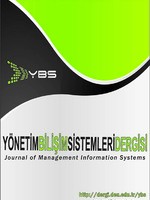LINGUISTIC STUDIES ON TWEETS GATHERED FROM MUĞLA REGION: A PRELIMINARY STUDY
LINGUISTIC STUDIES ON TWEETS GATHERED FROM MUĞLA REGION: A PRELIMINARY STUDY
___
- Anantharam, P., Barnaghi, P., Thirunarayan, K., and Sheth, A. (2015). Extracting city traffic events from social streams. ACM Transactions on Intelligent Systems and Technology (TIST), 6(4), 43.
- Bakıcı, T., Almirall, E., and Wareham, J. (2013). A smart city initiative: the case of Barcelona. Journal of the Knowledge Economy, 4(2), 135-148.
- Bowerman, B., et al. "The vision of a smart city." 2nd International Life Extension Technology Workshop, Paris. Vol. 28. 2000.
- Cavazos-Rehg, P.A., Krauss, M.J., Sowles, S., Connolly, S., Rosas, C., Bharadwaj, M., and Bierut, L.J. (2016). A content analysis of depression-related tweets. Computers in Human Behavior, 54: 351-357.
- Demirci, S. (2014). Emotion Analysis On Turkish Tweets. M.Sc. Thesis, Middle East Technical University, Ankara.
- Friedman, W. (1922). The Index of Coincidence and Its Applications in Cryptography. Publication No. 22. Geneva IL: Riverbank Publications.
- Ilina, E., Hauff, C., Celik, I., Abel, F., and Houben, G.J. (2012). Social event detection on twitter. In Web Engineering (pp. 169-176). Springer Berlin Heidelberg.
- INFOSEC Institute, Crowdsensing: State of the Art and Privacy Aspects, http://resources.infosecinstitute.com/crowdsensing-state-art-privacy-aspects/, 2014.
- Kit, C., and Wilks, Y. (1998). The Virtual Approach to Deriving Ngram Statistics from Large Scale Corpora. International Conference on Chinese Information Processing Conference, Beijing, China, pp. 223—229.
- Kunneman, F., Hürriyetoğlu, A., Oostdijk, N., and van den Bosch, A. (2014). Timely identification of event start dates from Twitter. Computational Linguistics in the Netherlands Journal, 4: 39-52.
- Leung, D., Law, R., Van Hoof, H., and Buhalis, D. (2013). Social media in tourism and hospitality: A literature review. Journal of Travel & Tourism Marketing, 30(1-2), 3-22.
- Menezes, A., van Oorschot, P. and Vanstone, S. (1996). Handbook of Applied Cryptography. CRC Press.
- Mohammad, S.M., and Kiritchenko, S. (2015). Using Hashtags to Capture Fine Emotion Categories From Tweets. Computational Intelligence, 31 (2): 301-326.
- Örücü, F. (2009). Turkish Language Characteristics And Author Identification. M.Sc. Thesis, Dokuz Eylül University, İzmir.
- Preece, A., Webberley, W., and Braines D. (2015). Tasking the tweeters: Obtaining actionable information from human sensors. SPIE Defense+ Security. International Society for Optics and Photonics.
- Quercia, D., Schifanella, R., and Aiello, L.M. (2014). The shortest path to happiness: Recommending beautiful, quiet, and happy routes in the city. In Proceedings of the 25th ACM conference on Hypertext and social media (pp. 116-125). ACM.
- Roitman, H., et al. Harnessing the crowds for smart city sensing. Proceedings of the 1st international workshop on Multimodal crowd sensing. ACM, 2012.
- Serrano, E., Iglesias, C.A., and Garijo, M. (2015). A Survey of Twitter Rumor Spreading Simulations. ICCCI 2015: 7th International Conference, September 21-23 2015, Madrid, Spain, pp. 113-122.
- Shendge, G.V., Pawar, M.R., Patil, N.D., Pawar, P.R., and Bagul, D.B. (2015). Real time Tweet analysis for event detection & reporting system for Earthquake. IRJET: International Research Journal of Engineering and Technology, 2 (6): 706-712.
- Tumasjan, A., Sprenger, T.O., Sandner, P.G., and Welpe, I.M. (2010). Predicting elections with Twitter:What 140 characters reveal about political sentiment. 4th International AAAI Conference on Weblogs and Social Media, May 23-26 2010, Washington, DC, pp. 178–185.
- Zanzotto, F.M., Pennacchiotti, M., and Tsioutsiouliklis, K. (2011). Linguistic redundancy in twitter. Proceedings of the Conference on Empirical Methods in Natural Language Processing. Association for Computational Linguistics.
- Zielinski, A., and Bügel, U. (2012). Multilingual analysis of twitter news in support of mass emergency events. Proceedings of the 9th International ISCRAM Conference, April 22-25 2012, Vancouver, Canada.
- ISSN: 2630-550X
- Başlangıç: 2015
- Yayıncı: Vahap TECİM
LET THE STUDENTS DECIDE: A PERSONALISED RANKING OF TURKISH UNIVERSITIES
COMPARISON OF SAMPLING TECHNIQUES FOR IMBALANCED LEARNING
LINGUISTIC STUDIES ON TWEETS GATHERED FROM MUĞLA REGION: A PRELIMINARY STUDY
Feriştah DALKILIÇ, Enis KARAARSLAN, Ali HÜRRİYETOĞLU, Enis KARAARSLAN, Ali HÜRRİYETOĞLU
SAP UYGULAMALARININ SWOT ANALİZİ İLE İNCELENMESİ
Rabia SAYLAM, Mustafa KESKİNKILIÇ, Kürşad TİMUROĞLU
Tuğberk KAYA, Tunç MEDENİ, Mustafa SAĞSAN
EXPLORING THE FACTORS AFFECTING PURCHASE INTENTION IN MUSIC INDUSTRY
Mustafa AĞAOĞLU, Emine Serra YURTKORU, Yusuf ŞAHİN
Mohammed ALSADI, Sevinç GÜLSEÇEN, Elif KARTAL
RFID TABANLI HIZLI GEÇİŞ SİSTEMLERİ İÇİN İŞ AKIŞLARININ YÖNETİM AMAÇLI MODELLENMESİ
VAHAP TECİM, Metin TOPALLAR, Murat EMÇ, Süleyman ŞENTÜRK, Can AYDIN
PCAP PAKETLER İLE RESTFULL API’Yİ GERÇEK ZAMANLI DİNLEM
Eda Sena KARAAĞAÇLI, Ahmet Anıl MÜNGEN, Hakan ERDÖL
ADLİ BİLİŞİMDE SİLİNMİŞ DOSYALARIN KURTARILMASI ÜZERİNE KARŞILAŞTIRMALI YÖNTEMLER
